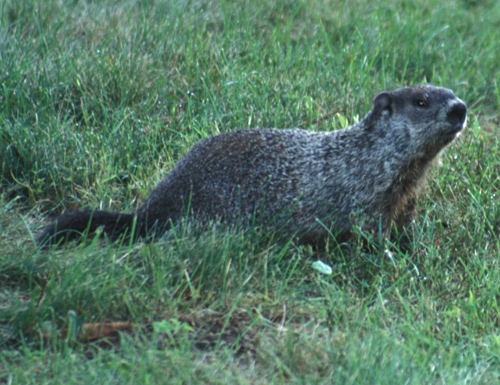Woodchucks, also commonly called Groundhogs, are a type of marmot common in Connecticut. They have red-brown to black-brown fur with white hairs mixed in. Their bodies are chunky and they have a bushy, flattish tail 3 to 6 inches long. They have the prominent incisors common to rodents. The claws on their feet are long and curved, adapted for digging. They weigh 4 to 14 lbs.
Woodchucks range through the northeastern quarter of the US, and up through a large portion of southern Canada. They are adpatable and will live in habitats from meadows to open woods. They are active only during the warm months and hibernate through the winter. Here hibernation usually begins in October. They are active during the day when not hibernating.
Woodchucks dig burrows several feet deep and up to 30 feet long, and they live there alone. Fresh dirt at the entrance of a hole 8 to 12 inches in diameter usually indicates an active burrow as Woodchucks regularly clean out their dens. This fresh dirt is at the main entrance. Other escape exits will be dug from the inside. Burrows will have a nesting chamber and a separate chamber for excrement. A winter hibernation burrow is usually dug with the hibernation chamber placed below the frost line.
All the burrowing is actually beneficial. It aerates the soil, mixes in organic matter and moisture, and brings deeper soil to the surface to begin the weathering process that creates topsoil. The underground excrement fertilizes soil. Many other animals make use of abandoned woodchuck burrows for shelter.
Typical diet in the wild consists of green plants. Woodchucks are often seen in lawns or by roadsides eating plants like grass, clover and dandelions. They love your garden plants. Fencing to keep woodchucks from the garden should be 3 ft high and extend underground a foot or two to prevent them from burrowing underneath. Woodchucks can climb trees up to about 15 ft to look for food or escape danger. They can also swim if necessary.
Male woodchucks emerge from hibernation first in early March and go visiting receptive females still in their burrows. One litter is produced each year in April to early May.
Woodchucks are usually busy feeding in the early morning and afternoon and tend to like to bask in the midday sun. They rarely move farther than 50 to 100 ft from their burrows and dive inside with an alarm whistle if threatened. They will fight if cornered.
Neat Facts
The Woodchuck's small round ears will close over its ear openings while the Woodchuck is underground digging. This keeps the dirt out of its ears.
Alas, Woodchucks are disinterested in their shadows at any time of year.
